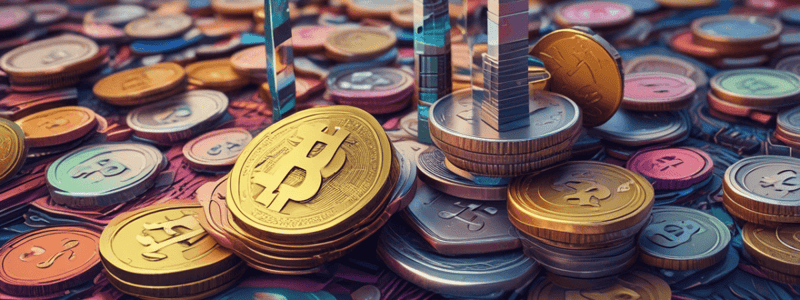Podcast
Questions and Answers
How are loans to large businesses typically arranged?
How are loans to large businesses typically arranged?
Loans to large businesses are arranged on a case by case basis, with an interest rate partially determined by the risk of the loan.
What type of security may the lender seek for a loan to a large business?
What type of security may the lender seek for a loan to a large business?
The lender will generally seek security, though this may be in the form of a covenant or a negative pledge.
How do banks make their money, and what factors can affect their net interest income (NII)?
How do banks make their money, and what factors can affect their net interest income (NII)?
Banks make their money through net interest income, which is the difference between the interest they earn on loans and the interest they pay on deposits. Factors that can affect NII include the spread between lending and deposit rates, regulation on liquid assets, changes in interest rates, and shifting customer preferences.
What are the main sources of funding for banks, as described in the text?
What are the main sources of funding for banks, as described in the text?
What are the main types of assets that banks hold on their balance sheets, according to the text?
What are the main types of assets that banks hold on their balance sheets, according to the text?
How can the future value (FV) of a deposit be calculated using the compound interest formula, given the present value (PV), interest rate (r), and time (t)?
How can the future value (FV) of a deposit be calculated using the compound interest formula, given the present value (PV), interest rate (r), and time (t)?
What is the relationship between risk and expected returns for investors?
What is the relationship between risk and expected returns for investors?
What does a narrow bid-ask spread indicate about the liquidity of a security?
What does a narrow bid-ask spread indicate about the liquidity of a security?
How is the risk-free rate of return typically measured?
How is the risk-free rate of return typically measured?
What is the credit spread, and how is it used to measure risk premiums?
What is the credit spread, and how is it used to measure risk premiums?
How does credit worthiness affect the risk premium required by investors?
How does credit worthiness affect the risk premium required by investors?
What are some methods used to measure the relative riskiness of an investment?
What are some methods used to measure the relative riskiness of an investment?
What is the Fisher Effect Relationship equation?
What is the Fisher Effect Relationship equation?
How are Treasury bonds priced?
How are Treasury bonds priced?
What does the Fisher Equation represent?
What does the Fisher Equation represent?
What does the real interest rate in the Fisher Equation refer to?
What does the real interest rate in the Fisher Equation refer to?
What causes changes in market yields according to the Fisher Effect?
What causes changes in market yields according to the Fisher Effect?
What influence did the Global Financial Crisis (GFC) have on Treasury Bond yields?
What influence did the Global Financial Crisis (GFC) have on Treasury Bond yields?
What is the formula for calculating the price of a bond on a coupon date?
What is the formula for calculating the price of a bond on a coupon date?
How are bond prices quoted?
How are bond prices quoted?
What is the settlement period for bonds?
What is the settlement period for bonds?
What is the relationship between bond prices and market yield?
What is the relationship between bond prices and market yield?
What is the significance of maturity in Treasury bonds?
What is the significance of maturity in Treasury bonds?
When calculating the yield on a bond, what is considered the yield rate?
When calculating the yield on a bond, what is considered the yield rate?
Explain the inverse relationship between bond prices and interest rates, and how it impacts existing and prospective investors.
Explain the inverse relationship between bond prices and interest rates, and how it impacts existing and prospective investors.
Differentiate between the money market and the bond market in terms of their respective time horizons and the interest rates they deal with.
Differentiate between the money market and the bond market in terms of their respective time horizons and the interest rates they deal with.
Explain the concept of a spread graph and its significance in the fixed-income market.
Explain the concept of a spread graph and its significance in the fixed-income market.
Describe the factors that determine the coupon rate of a bond and the significance of the face value (FV) payment at maturity.
Describe the factors that determine the coupon rate of a bond and the significance of the face value (FV) payment at maturity.
Explain the role of government bonds in the Australian bond market and their significance for banks and investors.
Explain the role of government bonds in the Australian bond market and their significance for banks and investors.
Differentiate between financial and non-financial corporate bonds, and provide examples of non-financial corporate bond issuers.
Differentiate between financial and non-financial corporate bonds, and provide examples of non-financial corporate bond issuers.
Flashcards are hidden until you start studying




